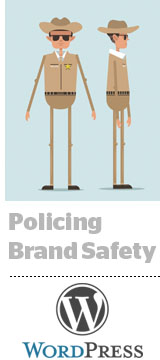
Because WordPress hosts numerous blogs and websites – it claims to power 31% of the internet – it has a tough time scaling its ability to police brand safety.
While brands can often find their audiences on WordPress domains, they can also find themselves next to unsavory content.
So WordPress, which runs an exchange called WordAds, usually only allows larger sites to advertise. But this conservatism leaves tons of brand safe inventory unmonetized for its publishers, said Jon Burke, advertising lead at WordPress’s parent company Automattic.
“It wasn’t worth the risk to try to run ads on those sites if we might be doing something that wasn’t brand safe,” he said. “But our model doesn’t really work if we can’t make money off of [publishers] running advertising because we can’t monitor for brand safety.”
After testing third-party brand safety tools and deploying human content moderators, WordPress realized it needed a bespoke solution to monitor its full network.
“WordPress is in so many different languages and countries, it can be challenging for a single system to be able to filter through all that,” Burke said. “[Available tools] just look at a website at a single point in time, but websites change.”
WordPress uses a tool from IPONWEB, which also built its supply-side platform and ad server, to monitor brand safety across all of its inventory in real time. The tool sits in WordPress’s ad server and aggregates contextual, image recognition and search ranking data to understand, at the page-level, whether an impression is suitable for a brand.
IPONWEB pulls data from search engines through API because they have some of the most scaled content moderation systems in the world. “They help us spot what’s not brand-safe in other countries,” Burke said. “A Brazilian advertiser might have different cultural sensitivities compared to one in Russia.”
Aggregating all of that data, rather than monitoring a specific page or website, helped WordPress better police for brand safety than it ever could using a single system, Burke said. With a more comprehensive ability to make sure its content is safe, WordPress has increased the number of its domains selling ads from 15,000 to up to 600,000.
“It makes the relationship [with site owners] more fair if we’re able to recoup some of the costs by running ads on their sites,” he said. “And it helps make brand advertisers more comfortable advertising with us.”
This post was syndicated from Ad Exchanger.


More Stories
Unbound joins HubSpot for elite client data
Citigroup Scales Back DEI Initiatives
Ticker: CBS News Tweaks Format of CBS Evening News